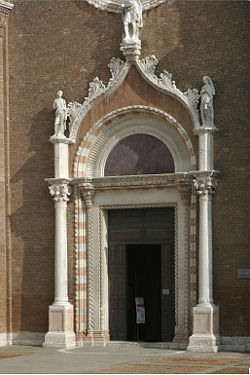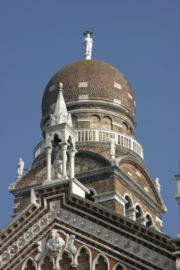
Madonna dell'Orto
Encyclopedia

Venice
Venice is a city in northern Italy which is renowned for the beauty of its setting, its architecture and its artworks. It is the capital of the Veneto region...
, Italy
Italy
Italy , officially the Italian Republic languages]] under the European Charter for Regional or Minority Languages. In each of these, Italy's official name is as follows:;;;;;;;;), is a unitary parliamentary republic in South-Central Europe. To the north it borders France, Switzerland, Austria and...
, in the sestiere
Sestiere
A sestiere is a subdivision of certain Italian towns and cities. The word is from sesto, or sixth; and is thus used only for towns divided into six districts. The best-known example are the sestieri of Venice, but Ascoli Piceno, Genoa, Milan and Rapallo, for example, were also divided into sestieri...
of Cannaregio
Cannaregio
Cannaregio is the northernmost of the six historic sestieri of Venice. It is the second largest sestiere by land area and the largest by population, with 13,169 people as of 2007....
.
History
The church was erected by the now-defunct religious order, the "HumiliatiHumiliati
The Humiliati were an Italian religious order of men formed probably in the 12th century. It was suppressed by a Papal bull in 1571 though an associated order of women continued into the 20th century.-Origin:Its origin is obscure...
" in the mid-14th century, under the direction of Tiberio da Parma, who is buried in the interior. It was initially dedicated to St. Christopher, patron saint of travellers, but its popular name suggesting consecration to Holy Virgin
Mary (mother of Jesus)
Mary , commonly referred to as "Saint Mary", "Mother Mary", the "Virgin Mary", the "Blessed Virgin Mary", or "Mary, Mother of God", was a Jewish woman of Nazareth in Galilee...
comes from the following century, when an allegedly miraculous statue of the Madonna, commissioned for the Church of S. Maria Formosa but rejected, was brought to the Church from the nearby orchard (orto in Italian) where it had languished.
The church lay on weak foundations and in 1399 a restoration project was financed by the city's Maggior Consiglio. The Humiliati, due to their "depraved customs", were ousted in 1462 and the Madonna dell'Orto was assigned to the congregation of Regular Canons of St. George. The latter order was suppressed in 1668, and the following year the Church and convent annexed were handed over to Cistercians of Lombardy. In 1787 the church came under public administration. Restoration was begun under Austrian rule in the 1840s and finished in 1869, by when Venice had become part of the unified Kingdom of Italy.
Façade
The façade, built in 1460-1464, has sloping sides and is in brickwork, divided in three parts by two pilasters strips. The two side sections have quadruple mullioned windows, while the central has a large rose windowRose window
A Rose window is often used as a generic term applied to a circular window, but is especially used for those found in churches of the Gothic architectural style and being divided into segments by stone mullions and tracery...
. The portal is surmounted by a pointed arch with white stone decorations portraying, on the summit, St. Christopher, the Madonna and the Archangel Gabriel by Nicolò di Giovanni Fiorentino and Antonio Rizzo. Under is a tympanum
Tympanum (architecture)
In architecture, a tympanum is the semi-circular or triangular decorative wall surface over an entrance, bounded by a lintel and arch. It often contains sculpture or other imagery or ornaments. Most architectural styles include this element....
, in porphyry
Porphyry (geology)
Porphyry is a variety of igneous rock consisting of large-grained crystals, such as feldspar or quartz, dispersed in a fine-grained feldspathic matrix or groundmass. The larger crystals are called phenocrysts...
, supported by circular pilaster strips. The whole is included into a porch
Porch
A porch is external to the walls of the main building proper, but may be enclosed by screen, latticework, broad windows, or other light frame walls extending from the main structure.There are various styles of porches, all of which depend on the architectural tradition of its location...
with Corinthian columns.

Interior
The interior has a nave and two aisles, with double-framed pointed arches supported by Greek marble columns. The transept is absent, while in the rear is a pentagonal apse decorated by paintings by Jacobo Robusti, known as TintorettoTintoretto
Tintoretto , real name Jacopo Comin, was a Venetian painter and a notable exponent of the Renaissance school. For his phenomenal energy in painting he was termed Il Furioso...
, who is buried here. The organ over the entrance was built in 1878, and is one of the most powerful in Venice.
At an altar to the south/right of the main entrance is St. John Baptist and Saints by Cima da Conegliano
Cima da Conegliano
Giovanni Battista Cima, also called Cima da Conegliano was an Italian Renaissance painter.-Biography:Giovanni Battista Cima was born at Conegliano, now part of the province of Treviso, in 1459 or 1460...
, and in the fourth chapel on the North/left facing the main altar, the Contarini Chapel, there is a notable St. Agnes by Tintoretto
Tintoretto
Tintoretto , real name Jacopo Comin, was a Venetian painter and a notable exponent of the Renaissance school. For his phenomenal energy in painting he was termed Il Furioso...
. The Renaissance Valier Chapel once housed a small Madonna with Child by Giovanni Bellini
Giovanni Bellini
Giovanni Bellini was an Italian Renaissance painter, probably the best known of the Bellini family of Venetian painters. His father was Jacopo Bellini, his brother was Gentile Bellini, and his brother-in-law was Andrea Mantegna. He is considered to have revolutionized Venetian painting, moving it...
(1481), stolen in 1993. Other works by Tintoretto in the church include a Presentation in the Temple (South aisle, close to the East end), Adoration of the Golden Calf, Last Judgement (both in the apse, either side of the main altar) and the Four Cardinal Virtues (in the upper storey of the apse, behind the altar), all from 1562-1564.
Bell tower
The bell tower, in brickwork, was finished in 1503. It has a square plan, with pilasters strips on the sides leading to the cell with circular mullioned windows. Four semicircular tympani divided the cell from the upper cylindrical tambour with an onion dome in Eastern style.On the sides are four statues of Evangelists of Pietro Lombardo
Pietro Lombardo
Pietro Lombardo was an Italian Renaissance sculptor and architect; born in Carona , he was the father of Tullio Lombardo and Antonio Lombardo....
's school; on the summit is a statue of the Redeemer, in white marble. The old bells, the largest being from 1424, were replaced in 1883.

